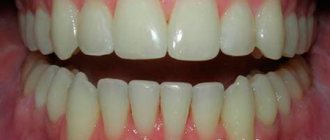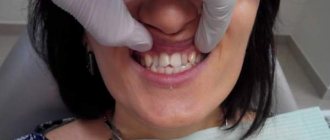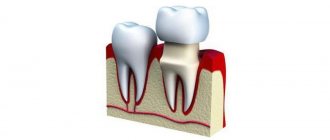General characteristics
Metal-ceramic dentures have many advantages , which include the following:
- high level of aesthetics. High-quality dentures installed in place of the front teeth look neat and are indistinguishable from natural ones;
- strength, durability. The metal frame of the prosthesis can withstand significant loads;
- no need for special care;
- long service life - about 15 years;
- resistance to various foods that can stain or destroy natural tooth enamel.
The frame of the product is made of an alloy containing nickel and chromium or chromium and cobalt. Sometimes the basis of the prosthesis is made up of compounds of non-ferrous metals, including gold, platinum, palladium. The thickness of the frame is from 0.3 to 0.5 mm.
Ceramic is applied to the base layer by layer. The crown is fired as it is applied in an oven at 800-950 degrees. Thanks to this technique, the specified materials are connected, guaranteeing high strength.
For reference. The highest quality and most durable option, which results in a high cost, is a metal-ceramic construction based on an alloy of palladium and gold.
Which crowns are best to choose for front teeth:
Indications for installation
Metal-ceramic dentures are installed if the following problems :
- chips and cracks;
- the need to restore the dentition in the absence of one or more teeth;
- congenital or acquired dentin pathologies;
- pronounced abrasion of enamel;
- advanced caries requiring tooth restoration.
Single dentures are installed if the tooth root has been preserved. They can also be installed on implants.
Process Features
Prosthetics includes several successive stages.
Installation proceeds as follows:
- an x-ray is taken to exclude the possibility of an inflammatory process at the root apex;
- the nerve is removed;
- if the crown is 50% destroyed, a pin is screwed into the root canal to strengthen the restored part. If it is destroyed down to the root, a stump inlay is made;
- the tooth is ground to achieve the thickness of the future prosthesis, doing this on each side. Hard tissue is ground down until a stump remains;
- they make an impression, based on which specialists make a metal-ceramic crown;
- during the construction period, which usually takes 1-2 weeks, the patient is given a temporary plastic structure;
- the manufactured system, which replaces natural teeth, is fixed in the oral cavity. First, the crown is secured with temporary cement. After 1-2 months, it is replaced with a long-term one, if the patient does not feel discomfort and additional adjustment of the crowns is not required.
After carrying out the necessary manipulations, the specialist advises the patient regarding oral care.
The process of installing a bridge on the front teeth:
The tooth under the crown hurts - what to do?
Unfortunately, there are situations when patients complain of such pain. Such unpleasant discomfort can occur immediately after prosthetics or a little later. If the pain lasts for too long, it is recommended to consult a dentist . There can be many causes of pain. For example, a previously unremoved nerve may become inflamed under the prosthesis. Uncomfortable treatment of the canals can also affect discomfort. An inexperienced doctor can leave an infection under the prosthesis, which will also negatively affect your well-being. Tooth pain under a crown can also be due to too little or too much filling material. Often, unscrupulous dentists accidentally leave fragments of instruments in the canal.
To avoid unpleasant consequences, you should not choose a clinic for prosthetics based on the price of the procedure alone. Give preference to highly qualified specialists who are well versed in which tooth crown is needed in which cases. Only an experienced doctor can solve your oral problems. The Artox clinic employs specialists who can help patients with the most complex anomalies. Here you can get rid of imperfections and get the smile you want. A bridge or crown for molars, prosthetics for front teeth and other types of operations are available to you right now.
Methods of attaching metal ceramics to the front teeth
Crowns are installed in a specific way , depending on whether the tooth root has been preserved or not.
- If the root is preserved , then the canal in which it is located is filled with filling material. Next, a metal pin is placed there and carefully fixed. The coronal part is ground down to form a stump, after which a new artificial crown is attached. Another way to install a prosthesis is to use a stump tab, the root part of which is fixed in the canal with the root of the tooth. After installation, a metal-ceramic crown is attached to the stump;
- If there is no root, an implant is implanted into the empty space, which is subsequently covered with a crown. In this case, the adjacent teeth are not subjected to grinding or any other impact.
Stump pin tab Implant
Separate single crowns and bridge
There are two options for installing metal-ceramic products : a single crown or a bridge on adjacent teeth.
A single tooth is fixed to a damaged tooth that has been previously ground, or to a pin. In this case, the adjacent, undamaged teeth are not affected. The service life of such a structure will be about 10-15 years.
Single crowns
A bridge is required if several teeth in a row are missing (at least 4). A bridge is also the best option for severe damage to the marginal periodontium or for low-lying clinical crowns of abutment teeth.
Metal-ceramic bridge
Preparatory activities
Before installing metal-ceramic dentures on the front teeth, preparatory measures are carried out.
First, the supporting teeth are turned. This is required for reliable fixation of the crown.
Approximately 2 mm of dense dental tissue is removed from each side.
Note! Stitching is an extremely unpleasant procedure, therefore, even in the absence of a nerve, it is carried out under anesthesia.
In order to be able to firmly strengthen the prosthesis in the future, the roughness of the stump is formed. A ledge is created on the lower edge - this is required for the correct positioning of the crown.
To prevent the development of the inflammatory process, the pulp is removed and the dental canals are filled. Depulpation, that is, removal of the nerve, is necessary if there is a focus of inflammation at the apex of the root.
When installing crowns made of metal and ceramics on the front teeth, the nerve must be removed , since they belong to single roots. Depulpation is not necessary if multi-rooted teeth (for example, back teeth) are being treated.
If the patient has caries or poor-quality old fillings are observed, treatment and replacement must be carried out before prosthetics.
How an impression is taken:
Installation and fixation
Installation of a metal-ceramic crown on the front teeth is as follows::
- First, the problem teeth are ground down on all sides. At the end of this process, they take on a cone shape and taper towards the cutting part. First, the lateral surfaces of the teeth adjacent to the prosthetic area are ground. Next, the outer part is prepared to give a flat shape. A border ledge is formed above the gum pocket, the surface is ground from the tongue side;
- then impressions are taken, which serve as a model for the manufacture of metal-ceramic crowns. Silicone pastes are used for impressions. The prosthetic structure is made in dental laboratories. While it is being manufactured, temporary crowns are installed. They protect sharpened teeth and make their appearance more aesthetic;
- When the structure is prepared, the patient has temporary crowns removed and metal-ceramic crowns are tried on. If discomfort is felt, the design is adjusted by changing the shape or color;
- when the design is finally adjusted, the ceramic surface is treated with dental glaze in order to obtain a natural shade;
- The crown is fixed to the front teeth with a special adhesive.
The issue of fixing a metal-ceramic crown to an abutment tooth deserves special attention. The structure is disinfected and degreased, and cotton swabs are placed around the supporting tooth. The crown is secured using special cement in liquid form, which easily comes out from under the crown during its installation.
Cement is poured inside the finished installed product, one-third, and also applied to its edges. Next, the prosthesis is placed on the supporting tooth.
After the cement has hardened, the excess is removed. To prevent the structure from moving, the patient should not eat anything for several hours after installation of the prosthesis. During the period specified by the doctor, you should keep your jaws closed.
Crowns or veneers?
Crowns and veneers are equally popular when replacing front teeth. Let's look at the main differences between these types of prosthetics:
We invite you to familiarize yourself with the lump under the root of a tooth
| Selection criterion | Crowns | Veneers |
| Appearance | Depends on the selected material | Absolutely aesthetic |
| Price | Depending on the material of the product, it ranges from 700 rubles to 20,000 rubles per piece | 7–8 thousand rubles per piece |
| Size | They have thick walls; installation requires removal of a large layer of enamel | Thin walls, reduced installation trauma |
Aesthetics, size and cost are the main criteria that guide the selection of a type of prosthesis. However, in addition to the basic characteristics, it is worth considering small nuances. For example, the condition of the teeth, the structure of the bone tissue, etc. You need to make a final decision about which crowns are best to place in consultation with an orthopedic dentist.
Prosthetics without pulp removal
Depulping and turning are required for prosthetic restoration of single-rooted teeth.
This is also necessary for deep caries or inflammation of the pulp. Also, removal of the nerve before installing a metal-ceramic crown is necessary for severe anomalies (for example, if the teeth are tilted or strongly pushed forward).
Placement of crowns without depulpation is carried out as follows:
- The tooth surface is treated using large amounts of water. An anesthetic is first administered and treated under the crown;
- in order to avoid infection, it is necessary to apply a special protective coating upon completion of treatment;
- Temporary crowns are placed on teeth with closed dental tubules.
In the future, similar manipulations are performed to check the finished prostheses and install them.
Fluoridation procedure
Most patients want to maintain the health of their teeth, and not mask the problem with veneers. In this case, you will need to undergo treatment at the dentist. Many experts suggest solving the problem of transparency by fluoridating tooth enamel. The procedure is often prescribed not only to combat an existing disease, but also for prevention purposes.
Fluoridation is a coating of tooth enamel with a special composition. The procedure is completely safe and can be performed even on children. Special solutions are applied to the enamel, which saturate it with fluoride ions. To do this, use a dental form filled with a medicinal mixture. It is put on the teeth and left for 20 minutes. The procedure can be performed no more than 15 times in a row.
Recently, more and more patients are turning to dentists for advice on how to restore tooth enamel in an even more effective way. For this purpose, a deep fluoridation procedure is recommended. It is carried out in several stages:
- The doctor performs professional teeth cleaning, removing stones and plaque.
- A stream of warm air dries the enamel.
- A special dental composition is applied to the surface of the teeth.
- Air drying is used again.
- A cotton swab is soaked in a liquid that contains calcium and copper hydroxide.
- Each tooth is treated with this product.
- Finally, rinse your mouth thoroughly.
Deep fluoridation increases the strength of teeth and prevents calcium leaching. This procedure can be used no more than once a year.
Possible complications
The possibility of chipping the ceramic coating is one of the disadvantages of metal-ceramic crowns.
During prosthetics, as well as after installation of metal-ceramic crowns, the following complications may occur :
- a feeling of discomfort, which usually occurs due to inadequate fitting of the prosthesis;
- discrepancy between the shade of the crowns and the color of the remaining teeth;
- crown loss or cement washout, which occurs when low-quality materials are used for fixation;
- increased sensitivity;
- incomplete fit of the crown, which causes pain and inflammation of the gums.
Reasons for transparency
The enamel has a white and rich tint. But under the influence of pathological and other factors, it loses its original color, becoming transparent. Teeth in this condition acquire a gray tint and an uncharacteristic shine. In advanced cases, this phenomenon spreads over their entire surface.
On this topic
- Other
Find out why teeth rot
- Maria Konstantinovna Tevs
- October 5, 2020
The main reason for the appearance of transparency is the thinning of the enamel. The pathological process occurs due to a lack of calcium in the body. If teeth become transparent due to thinning enamel, then they begin to break more often under pressure. Such changes are characterized by:
- the appearance of fragility;
- frequent damage ;
- the appearance of cracks.
In addition to these consequences of thinning enamel, affected teeth experience increased sensitivity to sweet, sour, cold and hot foods.
In addition, a carious cavity develops faster on a transparent surface. Treatment of this phenomenon is complicated by the fact that even the simplest dental procedures cause acute and unbearable pain in the patient.
The appearance of teeth transparency is facilitated by the influence of the following factors:
- Oral diseases Thinning of the enamel occurs under the influence of caries, periodontitis, and neoplasms of various types.
- The presence of a hereditary predisposition.
- Insufficient oral hygiene Enamel destruction occurs due to infrequent brushing of teeth, using too hard a brush, using inappropriate toothpastes and other products.
- Frequent whitening. The composition of the drugs used in this procedure includes aggressive substances, the effects of which can destroy tooth enamel.
- Exposure to acids. Thinning of the enamel occurs due to frequent consumption of sweet foods and carbonated drinks. They provoke the active production of saliva containing acids.
- Long-term use of certain medications (mainly antibiotics).
- Diseases of the gastrointestinal tract. The problem under consideration arises in pathologies accompanied by an increase in the level of stomach acidity.
- Living in a region with poor environmental conditions.
- Insufficient saliva production.
- Frequent drying of the mucous membrane.
- An abundance of dental plaque, which disrupts the supply of oxygen to hard tissues.
- Addiction to smoking.
Insufficient consumption of calcium and fluoride-containing products can provoke the appearance of transparent teeth. The occurrence of the problem in question occurs due to excessively active cleaning of the enamel performed during the hygiene procedure. Possible reasons for the appearance of transparency include injury or grinding of teeth.
Advantages and disadvantages
Table 1. Advantages and disadvantages of metal-ceramic crowns for anterior teeth.
| Advantages | Flaws |
|
|
About the pros and cons of metal-ceramic crowns:
Metal-free
In dentistry, metal-free products are usually crowns for the front teeth made of zirconia, plastic or porcelain. At the same time, the cheapest, but least reliable option is considered to be ceramic crowns with the inclusion of plastic, which are subject to very rapid abrasion. Next come porcelain crowns, which are in the middle in terms of price and also have high reliability, but are only suitable for single installations. If you need to create a reliable bridge (for example, for three teeth), then the choice automatically falls on high-strength ceramics with zirconium dioxide.
Pros:
- Zirconium, porcelain and plastic crowns can fully reproduce the color and transparency of natural teeth. In other words, it is very difficult to distinguish such products from real teeth. This effect is due to the fact that the main component of such crowns, ceramics, fully corresponds in optical properties to natural enamel.
- The high degree of stability of the aesthetic qualities of all-ceramic crowns for the front teeth guarantees the preservation of the appearance of the product over a long period of time. After all, as you know, ceramics are protected from staining with the color of coloring products and do not lose their original shine over time.
We suggest you familiarize yourself with how much it costs to put braces on your teeth, their types and price
. Cons:
- High cost (in particular, for those manufactured on the basis of zirconium).
- Quick erasing (applies to plastic crowns only).
Photos before and after installing metal-ceramic crowns on teeth
Restoring damaged teeth with crowns
Restoration and replacement of missing teeth with crowns
Installation of a metal-ceramic bridge on stump-like inlays
Restoration of anterior teeth with a metal-ceramic bridge with the addition of a missing pair
Installation of crowns after turning
Dental prosthetics with crowns – when is it necessary?
Installation of crowns is necessary in many cases:
- the tooth is severely damaged as a result of trauma;
- it is necessary to protect the root filling;
- prosthetics with a bridge is indicated;
- as a result of installing a filling that is too large, the tooth is greatly weakened;
- the patient wishes to improve aesthetics;
- a pin or stump was installed;
- implant inserted.
A crown on a healthy tooth that is accidentally broken as a result of any impact can only be installed after consultation with an experienced doctor. The dentist should examine the oral cavity and give appropriate recommendations to the patient.
Price
| Type of design | Price (rubles) |
| Installation on cobalt and chromium alloy | From 4500 |
| Installation on gold-palladium alloy | From 17000 |
| Zirconium installation (metal-free) | 22500 |
| Dental bridge made of metal-ceramics (base – zirconium dioxide) | From 31000 |
| Metal-ceramic bridge on a cobalt-chromium basis | From 15000 |
Popular questions
What crown color should I choose?
The color of the coating is selected during the manufacturing process of the prosthesis so that its shade is similar to the shade of the rest of the teeth. To avoid mistakes, special color plates are used.
Which is better: metal ceramics or zirconium?
Zirconium oxide is suitable for prosthetics of both pulpless and living teeth. This material, like metal-ceramics, is durable, but much more expensive (the price of one metal-ceramic crown is from 4,500 rubles, from zirconium - from 16,000 rubles). Zirconium oxide has fewer contraindications, does not become a source of allergic reactions, and is not translucent. The final choice of material for the prosthesis depends on the financial capabilities of the patient, as well as medical indications.











